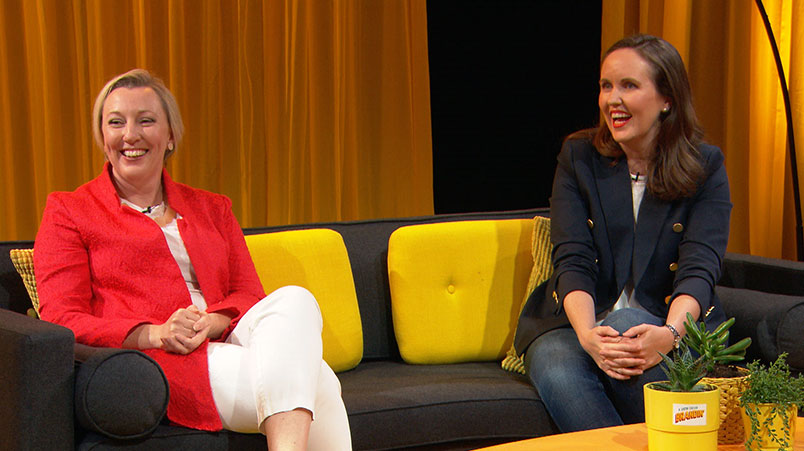A Show Called Brandin' - balancing brand and performance, why marketers are fluffing ROI measurement and what not to ask in pitches

Deloitte CMO Rochelle Tognetti and Volvo counterpart Julie Hutchinson get on a roll on the CMO Couch
Marketers are obsessed with metrics. Yet nine in ten are flubbing ROI measurement, at least in the B2B world. Meanwhile, balancing brand spend versus performance marketing is getting harder post-Covid, and brands risk becoming blands, according to Net-a-Porter cofounder Megan Quinn and Spark Foundry CEO, Imogen Hewitt. But that doesn't apply to subscription-based toilet paper, the hot product in Deloitte CMO Rochelle Tognetti's life, while Volvo CMO Julie Hutchinson has a moment of revelation. It's all in this week's episode of A Show Called Brandin'...
Check out episode three of A Show Called Brandin' with Net-a-Porter cofounder Megan Quinn and Spark Foundry CEO, Imogen Hewitt below:
Brought to you by LinkedIn, The Behaviour Report and Mi3, A Show Called Brandin’ looks at brands in culture, creativity and commerce. Each episode explores one of five principles of growth identified by LinkedIn’s B2B Institute fellows, Les Binet and Peter Field. This one is all about balancing brand and activation.
The heat is on
Every good marketer understands both brand building and activation are required to fill the funnel and company coffers. But getting the mix right isn’t easy. Timing is everything, says The Behaviour Report’s Dan Gregory – and that applies to measuring ROI, which sadly, many are getting horribly wrong.
The right ratios and what not to ask in pitches
All that said, marketers and planners still obsess with brand/activation ratios. Binet and Field suggest it is broadly 50/50 in B2B and as a rule 60/40 in B2C, with variations by category.
According to Spark Foundry CEO, Imogen Hewitt, it’s the one question guaranteed to come up in pitches. “But basically, it’s not that simple,” she says.
“There are other factors that you need to have in mind before you can get to the perfect mix for a business or brand.” And it’s pretty pointless to even attempt a guess in a pitch situation without access to brand data – so marketers reviewing agency arrangements, cross that one off the list.
Net-a-Porter cofounder, former ad agency creative director and serial entrepreneur, Megan Quinn, says brand was always central in creating the designer fashion site – and had to be, given the brands it needed to attract to the platform before e-commerce was much of a thing.
“It was humbling. When we went to the bigger brands, we had to show that we were worthy of partnering with them. They’d spent an enormous amount of time – decades, sometimes centuries – establishing their brands, so we had to earn their trust,” she says.
“We would go to the extent that if somebody bought a pair of Jimmy Choo shoes, we would put their box inside one of our boxes. So that their brand was never diminished because of the association with us.”
But Net-a-Porter was also bringing something to the party.
“We were sharing information with them, showing them new markets,” says Quinn. “They could only afford to have a finite number of flagship stores around the world - and we were showing them where they had other customers that they would not have even known about.”
The other balancing act: brand personality
Asked what brands should be doing better, Quinn pulls no punches.
“Just so, so much. They are so homogenous, largely … Give us a little bit of passion and a taste of your brand. Make it worth my while and my money. Energise me, excite me, speak to me,” she virtually sobs. “It seems they are all just focusing on bottom line and efficiencies – or copying other entities instead of actually expressing themselves.”
The agency leader is slightly more diplomatic.
“We can be so worried about appealing to everybody that we can end up appealing to no one – because there is no point of difference, nothing memorable,” says Hewitt.
“So you need to get the balance right with how much risk you are prepared to take in order to have a distinctive personality to get more out of the people that will love that – and not worry so much about the fact that some people won’t.”
The worst of all worlds is to do nothing and treat the brand as a plaque, she says.
“That’s a massive waste.”
Fortunately, the calibre of marketer that engages with Brandin’ would never take that approach. The two that joined Mi3’s Paul McIntyre this week on the CMO Couch offered another enlightening take on the brands that have captured a piece of their minds.
CMOs favourite brands: Who gives a crap?
Asked her favourite brand, Deloitte CMO Rochelle Tognetti is refreshingly honest: “Who Gives A Crap?”
In a post-Covid world, the subscription toilet paper company is literally on a roll. It’s just had its biggest ever year and made its biggest ever charitable donation of $5.85m (per the company, “the first few months of 2020 were a wild time for the toilet paper business”).
“I love Who Gives A Crap. They are so creative in what they do with toilet paper, the way they communicate to customers,” says Tognetti. “They are fun, playful – they are one of the few emails I will actually read.”
For B2B brands, she rates Adobe and Salesforce: “Dreamforce is an explosion of creativity.”
Harris Farm Markets and cosmetics brand Rationale are Julie Hutchinson’s top picks. But she struggled to land on a standout B2B brand – other than Brandin’ show sponsor LinkedIn, naturally.
Yet just pondering the question brought forth a Damascene conversion for the Volvo CMO: “I realised that in talking to Volvo dealers, giving them confidence levels in what we are doing from a branding perspective, I am actually in B2B," says Hutchinson. “It was a moment of realisation.”
Witness the power of the CMO Couch.

